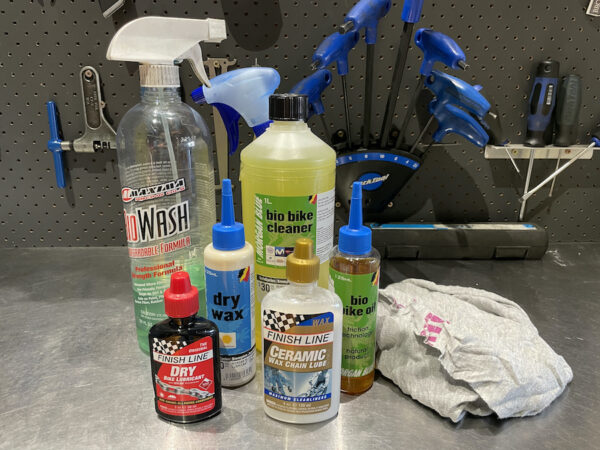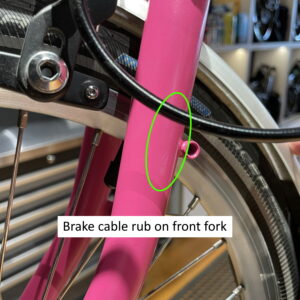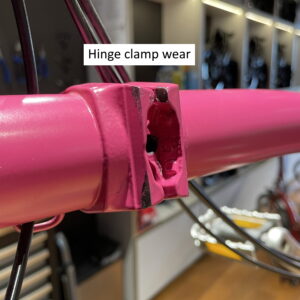
Now that you’ve bought your Brompton
Congratulations and welcome to the fold!
Once you’ve had a chance to enjoy riding your Brompton, practice the fold, and start looking at it a bit closer, it’s common for new owners to have a few questions. Here we answer a few of the most frequently asked questions (to us and posted online) by new Brompton owners.
My paint is coming off!
Yes, it will, from a few places on the frame.
Brompton “paint” is a powder coat – think of it like a plastic coating which has been melted onto the frame. A powder coat is tough, durable and doesn’t chip or flake when struck, but will wear off on contact points. There are a lot of contact points on a Brompton! They’re generally small and well hidden, but as a rule of thumb the more often you fold and unfold your bike, the faster your paint will wear.
Firstly, here are some photos from one of our hire Bromptons which is starting to show some typical wear. Paint always starts coming off at the contact points where your hinges are clamped. There’s a lot of friction here and only a (relatively) thin layer of paint/plastic between metal components. The paint here is first to go because the metal parts are literally squashing and rubbing the paint off these touch points. The next places to show wear are the plastic-on-metal rub points, which is mostly along your cable lines.
For comparison, here’s our store manager Dayna’s original Brompton (>6yo) which has seen a lot of use as her main commuter. (Click to enlarge the images.)
do you sell touch up paint?
No, we don’t. Generally we recommend a visit to a hobby shop where you can find very small tins of paint in a wide range of colours. If you’re just wanting to seal a scratch, then clear nail polish will also do the job (once the area is clean and dry).
If you’re looking to protect your frame from cable rub we’d recommend a different strategy such as tough clear tape (hockey tape, helicopter tape) which can be replaced as required. If you want to disguise signs of wear as well as protecting your frame from further rubbing, you can investigate other permanent protectors.
My rear wheel makes a loud noise
Sturmey Archer hubs certainly do, particularly in the highest gear. “Sturmeys” are the large hubs in the rear wheels of 3 and 6 speed Bromptons which house your internal gears. You may have been too distracted to notice the sound on your test ride, but we promise it was there then, too.
The clicking noise is made by hub parts called “pawls” which are small metal flaps. When you pedal, these flaps lock into a jagged surface which in effect turns the hub and moves the bike forward. Different pawls are used in different gears. The pawls that are not being used simply flap past the jagged surface – kinda like a stick being dragged past a picket fence. The faster the wheel spins, the more noise the hub makes because the pawls are contacting more frequently.
The rear wheel on a two speed Brompton isn’t particularly loud – it’s a simple freehub. Many road bikes have far noisier hubs.
My bike is making a 'funny noise'
There are a numerous reasons why and places where your Brompton starts making an odd noise. Here are a few common ones:
- Front or rear tyres rubbing against mudguards/mudguard stays. The mudguard stays are basically heavy gauge wire and will bend with repeated pressure – when you fold under your rear wheel, for instance. Solution: encourage them back into shape by pushing together and/or pulling to the side until they and the mudguard are clear of the tyre. Also check for a build up of mud/dirt under your mudguards.
- Mudguard roller (L types only). When the little wheel on your rear mudguard rolls freely, it also rattles a lot when you ride. Solution: either learn to tune out the noise, or replace the roller. Check it isn’t also your mudguard stays that may be loose.
- Folding Pedal. The plastic platform can make a “click” with each stroke. Solution: ride with the pedal platform side down. This is the heavier side and will usually flip so this side is face down (gravity doing it’s thing there) when your foot’s not on the pedal.
- Leather Saddle. A Brooks Leather saddle is a classic pairing with a Brompton bike, but be prepared that the movement of leather on metal will often make a creaking sound, particularly uphills when you’re putting in more effort. It’s hardly a deal breaker, but can catch people by surprise if they haven’t ridden on a leather saddle before. Solution: learn to tune it out, or change to a different saddle. *Also check there’s no play in your pentaclip (saddle clamp) – there should not be any ‘wiggle’ or ‘rocking motion’ between the nose and the rear of the saddle.*
- Suspension Block. After a bit of time the this can develop a bit of a squeak. When not on the bike, lean your weight on the saddle and bounce a few times. This is a good way to isolate the noise if it’s coming from the rubber block. Solution: dismantle, clean, liberally grease with parts grease, reassemble. Sometimes an additional plastic washer (you can make yourself one from any fairly thick, durable plastic bag) between the suspension block and the rear frame.
- Front brake cable clicking against luggage block. Occasionally this cable is left a bit long and when you steer, the end of the cable comes into contact with the luggage block. No harm is caused, but it can drive you crazy if you don’t know what that noise is. Solution: bend the cable gently out of the way.
If your Brompton is making a noise that doesn’t fit any of the above, bring it in (or take it to your nearest Brompton dealer) and ask them to check it out. A video records of the sound, and what you’re doing when the sound happens, is also really handy. We can’t always replicate everything in the shop.
this has fallen off my bike - what is it?
On a new bike it’s probably going to be the bung for the seat post. These are a press-fit part and not vital to the operation of the bike. Until recently (~2017) seat posts on E-type (without mudguards) and L-type (with mudguards) Bromptons were issued without a bung – only the R-types got a pretty hefty rubber bung, although these were also available to purchase separately. The bung at the end of the seatpost acts like a park brake on a folded Brompton with a rear rack – particularly if you opted for the Brompton Eazy Wheel upgrade. An E- or L-type Brompton is far less likely to roll away from you when folded.
Occasionally we see online posts where handlebar catches have fallen off. These should be checked semi regularly as they do tend to come loose with use, but if your has come off it’s a simple matter of screwing it back on. Fold your Brompton and clip your handlebar in the catch to secure it at the proper angle.
How often do I need to pump my tyres
We suggest that tyre pressure is checked weekly to fortnightly, or before each ride if you ride less frequently. It helps to make it part of your weekly routine if you’re a daily commuter.
The recommended tyre pressure for most tyres compatible with a Brompton is 65-110psi (you can find this on the sidewall of your tyre). Where you will find most comfortable will depend mainly on your weight and comfort on the bike. Most of our customers ride at around 80-110psi. Get to know how much pressure your tyres lose over a week and top them up accordingly. The Kenda inner tubes that Bromptons come with are a little more porous than the replacement Schwalbe tubes we stock, but all tubes will leak air to some degree. Bromptons lose pressure faster because the tyres have less volume.
You will also need a pump that’s both efficient and easy to use on a regular basis. We usually recommend a floor pump – a style with a large chamber, a pressure gauge, and a good platform to stand on and keep the pump steady while you use it. A pump head with a lever on top will make it easier to fit between the spokes and securely onto the valve.
How often do I need to clean it
To be fair, this question isn’t asked quite often enough. “When it’s dirty” might sound like an obvious answer, but one that’s not very helpful to a novice rider.
The chain on a new Brompton has a wax coating. It lasts a while and sticks really well, even in light showers – but the downside is that everything else will stick to it, too. Therefore the “right” time to start practicing your clean and lube habit is when you notice gunk sticking to your chain. If you’ve been caught out in a downpour and you can feel (and maybe hear) the chain grinding against the chainring and sprockets (an unpleasant metal-on-metal sound), that’s a sure indication that you need to clean and lube your drive – once it’s dry, not still dripping wet.
“How do I clean it?” is generally the follow-up question.
You don’t need to get too fancy. We recommend the following:
- Chain lube – the descriptors “Wet” and “Dry” refers to the conditions you expect to be riding in.
“Dry” will suit most of our customers; less sticky, easier to clean, but will wash away easily in the rain.
“Wet” most suitable for all-weather commuters with a wet week forecast. It will stay on your chain, but so will everything else. Less easy to clean off.
There’s an almost infinite range of lube on the market, so have a browse ask us what we use and try a few for yourself. - Clean rags (Cotton or poly cotton) – old t-shirts, PJ’s, tea towels. Absorbent, but not fluffy.
- Bike wash or diluted car wash. Not hand soap or dishwashing liquid; the salts in these are not good for your bike.
- Toothpicks or bamboo skewers for picking sticks, stones, grass, and accumulated grunge out of your drive parts.
Using just a clean, dry rag you can keep your Brompton looking shiny and new – with perhaps just a bit of help from some bike wash as needed. The toothpicks can easily get into the jockey wheels of your chain tensioner (and other tricky places) without damaging these small plastic components. You may be amazed at what – and how much – gunk can accumulate here!

My brompton's going rusty!
If you live or ride near the sea, you can expect some components on your Brompton to start showing some small patches of surface rust reasonably quickly – just as components on any bike would. To stop or limit this happening you can start a frequent cleaning regime, or at least wipe down your bike after every (or most) rides. If you ride in the rain, let your Brompton dry unfolded if at all possible, and check there is no water pooling around the headstem bolt (open your handlebar hinge). Parts that typically show rust first are:
- Brake pad holder bolt
- Chainring bolts
- Axle nuts
- Indicator chain
- Seat post
As mentioned above, all Bromptons receive a power coat finish – satin, gloss and lacquer. Powder coating produces a very durable coating, but at the same time it is very slightly porous. Bromptons that are kept in high humidity environments, but not necessarily in salty ones, can expect to see surface oxidation on their frames earlier than Bromptons kept in drier, salt-free conditions.
Owners of Lacquered Bromptons have a window into the natural ageing process of a steel frame bike. Your new Brompton is like a puppy – gorgeous, desirable, and guaranteed to make you friends. But Bromptons (like puppies) don’t stay the same for long. The perfectly brazed joins, the permanent scorch marks from the heat required to melt brass (without also distorting the frame) catches eye and heart, and is what makes each lacquered Brompton so unique. Before long you will also witness the ageing process of the frame – surface oxidation can bloom or create “dragon trails” in different places, at different times on the frame. Our most valued possessions typically have as much character and story behind them as we do; let your Brompton be one of these.
***If you’re unsure about a noise, a rust spot or anything else you should contact your local Brompton dealer.***






